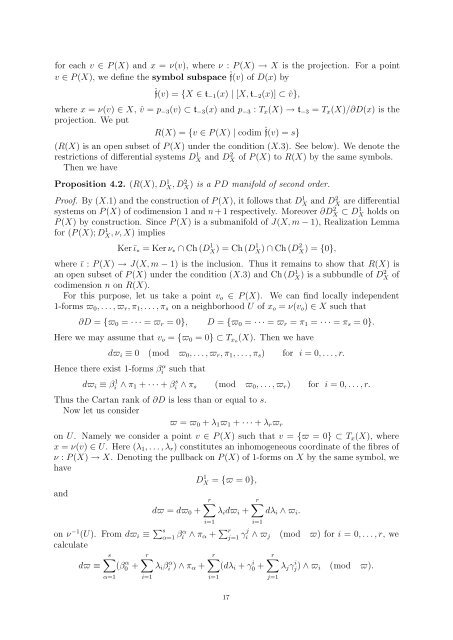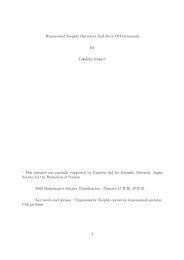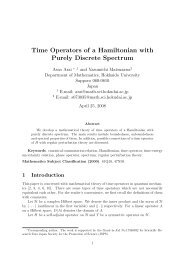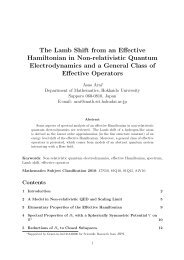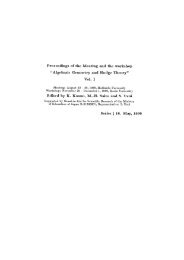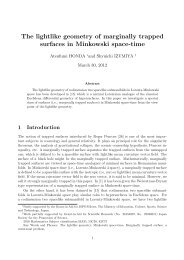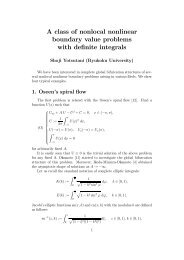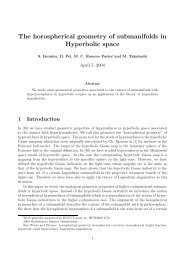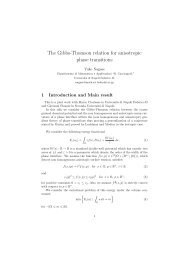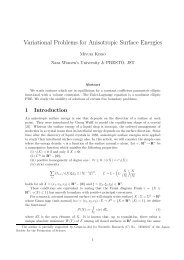Contact Geometry of second order I - Dept. Math, Hokkaido Univ ...
Contact Geometry of second order I - Dept. Math, Hokkaido Univ ...
Contact Geometry of second order I - Dept. Math, Hokkaido Univ ...
Create successful ePaper yourself
Turn your PDF publications into a flip-book with our unique Google optimized e-Paper software.
for each v ∈ P (X) and x = ν(v), where ν : P (X) → X is the projection. For a point<br />
v ∈ P (X), we define the symbol subspace ˆ f(v) <strong>of</strong> D(x) by<br />
ˆ f(v) = {X ∈ t−1(x) | [X, t−2(x)] ⊂ ˆv},<br />
where x = ν(v) ∈ X, ˆv = p−3(v) ⊂ t−3(x) and p−3 : Tx(X) → t−3 = Tx(X)/∂D(x) is the<br />
projection. We put<br />
R(X) = {v ∈ P (X) | codim ˆ f(v) = s}<br />
(R(X) is an open subset <strong>of</strong> P (X) under the condition (X.3). See below). We denote the<br />
restrictions <strong>of</strong> differential systems D1 X and D2 X <strong>of</strong> P (X) to R(X) by the same symbols.<br />
Then we have<br />
Proposition 4.2. (R(X), D1 X , D2 X ) is a P D manifold <strong>of</strong> <strong>second</strong> <strong>order</strong>.<br />
Pro<strong>of</strong>. By (X.1) and the construction <strong>of</strong> P (X), it follows that D1 X and D2 X are differential<br />
holds on<br />
systems on P (X) <strong>of</strong> codimension 1 and n + 1 respectively. Moreover ∂D2 X ⊂ D1 X<br />
P (X) by construction. Since P (X) is a submanifold <strong>of</strong> J(X, m − 1), Realization Lemma<br />
for (P (X); D1 X , ν, X) implies<br />
Ker ¯ι∗ = Ker ν∗ ∩ Ch (D 1 X) = Ch (D 1 X) ∩ Ch (D 2 X) = {0},<br />
where ¯ι : P (X) → J(X, m − 1) is the inclusion. Thus it remains to show that R(X) is<br />
an open subset <strong>of</strong> P (X) under the condition (X.3) and Ch (D 1 X ) is a subbundle <strong>of</strong> D2 X <strong>of</strong><br />
codimension n on R(X).<br />
For this purpose, let us take a point vo ∈ P (X). We can find locally independent<br />
1-forms ϖ0, . . . , ϖr, π1, . . . , πs on a neighborhood U <strong>of</strong> xo = ν(vo) ∈ X such that<br />
∂D = {ϖ0 = · · · = ϖr = 0}, D = {ϖ0 = · · · = ϖr = π1 = · · · = πs = 0}.<br />
Here we may assume that vo = {ϖ0 = 0} ⊂ Txo(X). Then we have<br />
dϖi ≡ 0 (mod ϖ0, . . . , ϖr, π1, . . . , πs) for i = 0, . . . , r.<br />
Hence there exist 1-forms β α i such that<br />
dϖi ≡ β 1 i ∧ π1 + · · · + β s i ∧ πs (mod ϖ0, . . . , ϖr) for i = 0, . . . , r.<br />
Thus the Cartan rank <strong>of</strong> ∂D is less than or equal to s.<br />
Now let us consider<br />
ϖ = ϖ0 + λ1ϖ1 + · · · + λrϖr<br />
on U. Namely we consider a point v ∈ P (X) such that v = {ϖ = 0} ⊂ Tx(X), where<br />
x = ν(v) ∈ U. Here (λ1, . . . , λr) constitutes an inhomogeneous coordinate <strong>of</strong> the fibres <strong>of</strong><br />
ν : P (X) → X. Denoting the pullback on P (X) <strong>of</strong> 1-forms on X by the same symbol, we<br />
have<br />
D 1 X = {ϖ = 0},<br />
and<br />
dϖ = dϖ0 +<br />
r∑<br />
λidϖi +<br />
i=1<br />
r∑<br />
dλi ∧ ϖi.<br />
on ν −1 (U). From dϖi ≡ ∑ s<br />
α=1 βα i ∧ πα + ∑ r<br />
j=1 γj<br />
i ∧ ϖj (mod ϖ) for i = 0, . . . , r, we<br />
calculate<br />
dϖ ≡<br />
s∑<br />
α=1<br />
(β α 0 +<br />
r∑<br />
i=1<br />
λiβ α i ) ∧ πα +<br />
r∑<br />
i=1<br />
i=1<br />
(dλi + γ i 0 +<br />
17<br />
r∑<br />
λjγ i j) ∧ ϖi (mod ϖ).<br />
j=1


